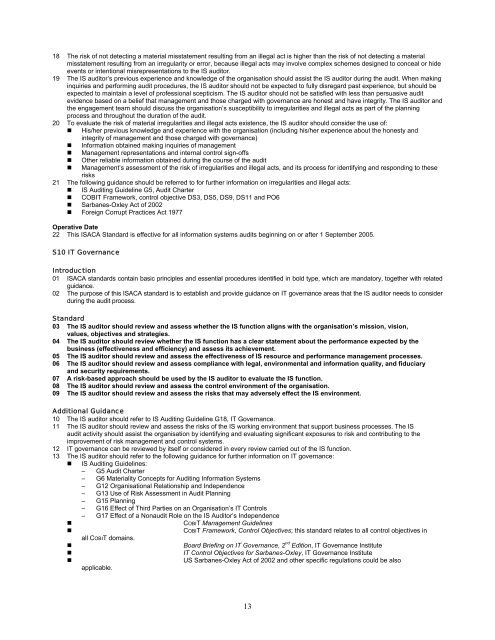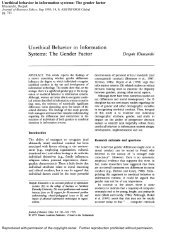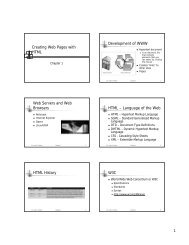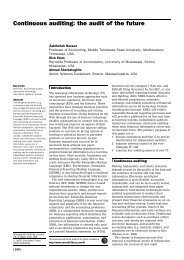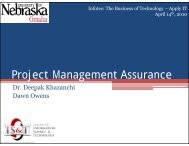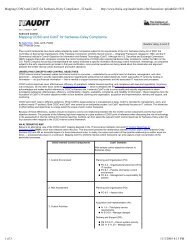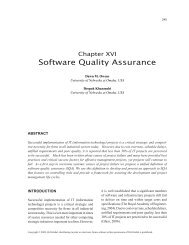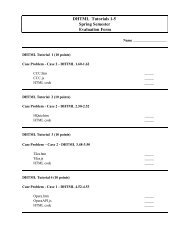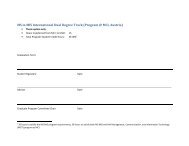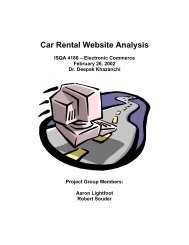IS Standards, Guidelines and Procedures for Auditing and Control ...
IS Standards, Guidelines and Procedures for Auditing and Control ...
IS Standards, Guidelines and Procedures for Auditing and Control ...
You also want an ePaper? Increase the reach of your titles
YUMPU automatically turns print PDFs into web optimized ePapers that Google loves.
18 The risk of not detecting a material misstatement resulting from an illegal act is higher than the risk of not detecting a materialmisstatement resulting from an irregularity or error, because illegal acts may involve complex schemes designed to conceal or hideevents or intentional misrepresentations to the <strong>IS</strong> auditor.19 The <strong>IS</strong> auditor’s previous experience <strong>and</strong> knowledge of the organisation should assist the <strong>IS</strong> auditor during the audit. When makinginquiries <strong>and</strong> per<strong>for</strong>ming audit procedures, the <strong>IS</strong> auditor should not be expected to fully disregard past experience, but should beexpected to maintain a level of professional scepticism. The <strong>IS</strong> auditor should not be satisfied with less than persuasive auditevidence based on a belief that management <strong>and</strong> those charged with governance are honest <strong>and</strong> have integrity. The <strong>IS</strong> auditor <strong>and</strong>the engagement team should discuss the organisation’s susceptibility to irregularities <strong>and</strong> illegal acts as part of the planningprocess <strong>and</strong> throughout the duration of the audit.20 To evaluate the risk of material irregularities <strong>and</strong> illegal acts existence, the <strong>IS</strong> auditor should consider the use of:• His/her previous knowledge <strong>and</strong> experience with the organisation (including his/her experience about the honesty <strong>and</strong>integrity of management <strong>and</strong> those charged with governance)• In<strong>for</strong>mation obtained making inquiries of management• Management representations <strong>and</strong> internal control sign-offs• Other reliable in<strong>for</strong>mation obtained during the course of the audit• Management’s assessment of the risk of irregularities <strong>and</strong> illegal acts, <strong>and</strong> its process <strong>for</strong> identifying <strong>and</strong> responding to theserisks21 The following guidance should be referred to <strong>for</strong> further in<strong>for</strong>mation on irregularities <strong>and</strong> illegal acts:• <strong>IS</strong> <strong>Auditing</strong> Guideline G5, Audit Charter• COBIT Framework, control objective DS3, DS5, DS9, DS11 <strong>and</strong> PO6• Sarbanes-Oxley Act of 2002• Foreign Corrupt Practices Act 1977Operative Date22 This <strong>IS</strong>ACA St<strong>and</strong>ard is effective <strong>for</strong> all in<strong>for</strong>mation systems audits beginning on or after 1 September 2005.S10 IT GovernanceIntroduction01 <strong>IS</strong>ACA st<strong>and</strong>ards contain basic principles <strong>and</strong> essential procedures identified in bold type, which are m<strong>and</strong>atory, together with relatedguidance.02 The purpose of this <strong>IS</strong>ACA st<strong>and</strong>ard is to establish <strong>and</strong> provide guidance on IT governance areas that the <strong>IS</strong> auditor needs to considerduring the audit process.St<strong>and</strong>ard03 The <strong>IS</strong> auditor should review <strong>and</strong> assess whether the <strong>IS</strong> function aligns with the organisation’s mission, vision,values, objectives <strong>and</strong> strategies.04 The <strong>IS</strong> auditor should review whether the <strong>IS</strong> function has a clear statement about the per<strong>for</strong>mance expected by thebusiness (effectiveness <strong>and</strong> efficiency) <strong>and</strong> assess its achievement.05 The <strong>IS</strong> auditor should review <strong>and</strong> assess the effectiveness of <strong>IS</strong> resource <strong>and</strong> per<strong>for</strong>mance management processes.06 The <strong>IS</strong> auditor should review <strong>and</strong> assess compliance with legal, environmental <strong>and</strong> in<strong>for</strong>mation quality, <strong>and</strong> fiduciary<strong>and</strong> security requirements.07 A risk-based approach should be used by the <strong>IS</strong> auditor to evaluate the <strong>IS</strong> function.08 The <strong>IS</strong> auditor should review <strong>and</strong> assess the control environment of the organisation.09 The <strong>IS</strong> auditor should review <strong>and</strong> assess the risks that may adversely effect the <strong>IS</strong> environment.Additional Guidance10 The <strong>IS</strong> auditor should refer to <strong>IS</strong> <strong>Auditing</strong> Guideline G18, IT Governance.11 The <strong>IS</strong> auditor should review <strong>and</strong> assess the risks of the <strong>IS</strong> working environment that support business processes. The <strong>IS</strong>audit activity should assist the organisation by identifying <strong>and</strong> evaluating significant exposures to risk <strong>and</strong> contributing to theimprovement of risk management <strong>and</strong> control systems.12 IT governance can be reviewed by itself or considered in every review carried out of the <strong>IS</strong> function.13 The <strong>IS</strong> auditor should refer to the following guidance <strong>for</strong> further in<strong>for</strong>mation on IT governance:• <strong>IS</strong> <strong>Auditing</strong> <strong>Guidelines</strong>:– G5 Audit Charter– G6 Materiality Concepts <strong>for</strong> <strong>Auditing</strong> In<strong>for</strong>mation Systems– G12 Organisational Relationship <strong>and</strong> Independence– G13 Use of Risk Assessment in Audit Planning– G15 Planning– G16 Effect of Third Parties on an Organisation’s IT <strong>Control</strong>s– G17 Effect of a Nonaudit Role on the <strong>IS</strong> Auditor’s Independence• COBIT Management <strong>Guidelines</strong>• COBIT Framework, <strong>Control</strong> Objectives; this st<strong>and</strong>ard relates to all control objectives inall COBIT domains.• Board Briefing on IT Governance, 2 nd Edition, IT Governance Institute• IT <strong>Control</strong> Objectives <strong>for</strong> Sarbanes-Oxley, IT Governance Institute• US Sarbanes-Oxley Act of 2002 <strong>and</strong> other specific regulations could be alsoapplicable.13


